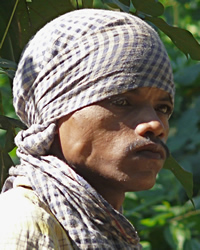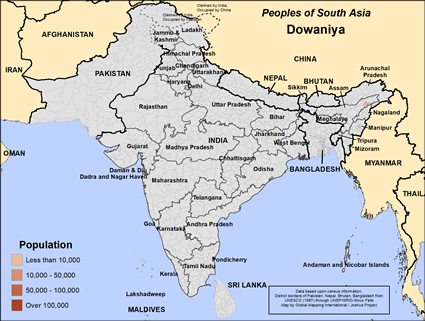Dowaniya in India

Photo Source:
Rita Willaert - Flickr
Creative Commons
|

Map Source:
People Group data: Omid. Map geography: UNESCO / GMI. Map Design: Joshua Project
|
| People Name: | Dowaniya |
| Country: | India |
| 10/40 Window: | Yes |
| Population: | 2,900 |
| World Population: | 2,900 |
| Primary Language: | Assamese |
| Primary Religion: | Buddhism |
| Christian Adherents: | 0.00 % |
| Evangelicals: | 0.00 % |
| Scripture: | Complete Bible |
| Ministry Resources: | Yes |
| Jesus Film: | Yes |
| Audio Recordings: | Yes |
| People Cluster: | South Asia Buddhist |
| Affinity Bloc: | South Asian Peoples |
| Progress Level: |
|
Introduction / History
The Dowaniya people are closely related to the Singhpo people who fled Burma in 1793. The ancestors of the Dowaniya people were also among those early Singhpo settlers. The Singhpo who were released from being serfs eventually morphed into the Dowaniya people. Their languages and histories share similarities. The Dowaniya usually speak Hindi and Assamese and use the Assamese script for writing.
Today the Indian government has not recognized the Dowaniya as a scheduled tribe, so their unofficial designation has caused them to be largely forgotten by the outside world.
Members of the Dowaniya community live in the north-east Indian state of Assam. They inhabit a number of different locations on the Assam plain, but many live in the district of Sibsagar, a short distance from the Brahmaputra River.
What Are Their Lives Like?
The Dowaniya people retain their traditional customs to this day. They have managed to keep the all-pervading Hindu culture at arm's length, especially those Dowaniya living further away from the towns. One source notes that they are experts in woodcraft, basketry and weaving.
What Are Their Beliefs?
When the Singhpo first entered India, they brought their belief in Theravada Buddhism with them. Most Dowaniya have continued as Buddhists, although their faith is now mixed with Hinduistic and animistic influences. They have their own Buddhist monks, who preside over birth rituals, weddings and funerals, and are also entrusted with the preservation of the ancient Buddhist texts.
What Are Their Needs?
There are no known Christian believers among the Dowaniya people. Throughout their long and troubled history, they have been waiting to hear the good news that Jesus loves them and has made a way for them to know the true God.
Prayer Points
Pray for workers to go to the Dowaniya people, and for their hearts to be ready to receive their savior.
Pray for families of believers loving and serving others to grow reproducing churches.
Pray for a chain reaction of families reaching families that results in thousands of new believers who share their faith with others.
Pray for grace and truth expanding into their entire society as all believers learn to love others.